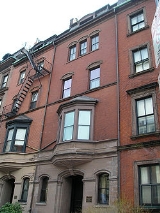
Gibson House Museum
Encyclopedia
The Gibson House Museum is a historic house museum located at 137 Beacon Street in the Back Bay, Boston, Massachusetts
. It preserves the 1860 building occupied by three generations of the Gibson family.
. Edward Clarke Cabot
designed the building which was finished by 1860 in the Italian Renaissance
style with an exterior of brownstone and red brick. She passed it on to her son Charles Hammond Gibson.
After Charles Hammond Gibson, Jr., Catherine Hammond Gibson's grandson died in 1954, the house became a museum in 1957, and in 2001 was declared a National Historic Landmark
. The Gibson House's landmark status is due to its claim that it is the only Victorian era row house in Boston's Back Bay to maintain the integral relationship between the exterior architectural shell and the original interior plan, with its accompanying decorative schemes. Its interior is a composite of family furnishings and pieces added to make it more complete.
Back Bay, Boston, Massachusetts
Back Bay is an officially recognized neighborhood of Boston, Massachusetts famous for its rows of Victorian brownstone homes, which are considered one of the best-preserved examples of 19th-century urban design in the United States, as well as numerous architecturally significant individual...
. It preserves the 1860 building occupied by three generations of the Gibson family.
History
The widowed Catherine Hammond Gibson purchased the newly filled in land for $3, 696 in 1859 in order to move away from Beacon HillBeacon Hill, Boston, Massachusetts
Beacon Hill is a historic neighborhood of Boston, Massachusetts, that along with the neighboring Back Bay is home to about 26,000 people. It is a neighborhood of Federal-style rowhouses and is known for its narrow, gas-lit streets and brick sidewalks...
. Edward Clarke Cabot
Edward Clarke Cabot
Edward Clarke Cabot was an American architect and artist.-Early life:Cabot's father was Samuel Cabot Jr., a shipping businessman. His mother was Eliza Perkins Cabot. He had two siblings: Dr. Samuel Cabot III , an eminent surgeon, and Walter Channing Cabot Edward Clarke Cabot (August 17, 1818...
designed the building which was finished by 1860 in the Italian Renaissance
Italian Renaissance
The Italian Renaissance began the opening phase of the Renaissance, a period of great cultural change and achievement in Europe that spanned the period from the end of the 13th century to about 1600, marking the transition between Medieval and Early Modern Europe...
style with an exterior of brownstone and red brick. She passed it on to her son Charles Hammond Gibson.
After Charles Hammond Gibson, Jr., Catherine Hammond Gibson's grandson died in 1954, the house became a museum in 1957, and in 2001 was declared a National Historic Landmark
National Historic Landmark
A National Historic Landmark is a building, site, structure, object, or district, that is officially recognized by the United States government for its historical significance...
. The Gibson House's landmark status is due to its claim that it is the only Victorian era row house in Boston's Back Bay to maintain the integral relationship between the exterior architectural shell and the original interior plan, with its accompanying decorative schemes. Its interior is a composite of family furnishings and pieces added to make it more complete.

